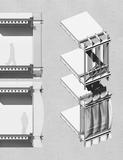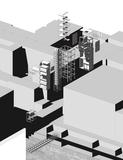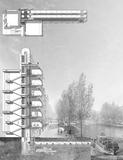
The Machines in the Garden
Dairan Xu; advised by Jonathan Bachrach, Sara Dean, Etienne Turpin, and Kyle Steinfeld

Paradigm shifts in the means of industrial production alter not only the way that goods are designed, produced, and distributed, but also hold social, spatial, and aesthetic implications that must be confronted. We have seen this to be true in the industrial revolution of the 19th century that gave rise to mechanized factories, the information revolution of the 20th century that gave rise to the modern office building, and we may find this to be true yet again in the ongoing transformations related to new advances in automation and artificial intelligence. This project aims to account for the potential new forms of architecture that arise from the spatial requirements of autonomous machines, of the humans that interface with them, and the relationship between these two. In contrast with overly utopian or dystopian narratives of an increasingly networked society, this speculation focuses on ways in which the efficient logics of artificial intelligence and the humanistic interests of people might synergistically combine for mutual benefit.
The primary design proposes a logistic warehouse for UPS, an office space used by both human and robots. Humans occupy the edge of building platform, allowing light and ventilation, while the space of robots is compact and dense. The design for the secondary Satellite Office project are package drop-off locations in six sites around the world. These projects explore the application of the generative design method to a series of design interventions, and balance a desire for formal homogeneity with a desire for performance-driven heterogeneity, at the service of climatic response. These designs use robot space to create better micro-climate for human and made it possible to for human to occupy space that they haven't used in the city. Modern highways reduce commute and other travel time, creating increased opportunities for people to travel and providing trade routes for goods. However, where highways are created through existing communities, there can be reduced community cohesion and more difficult local access. Since transportation is crucial for logistic industry, this project aims to improve the environmental quality under highway and integrate transportation system, distribution system and office space into one project.
Spray paint is one of the most important medium for graffiti. It is portable, homogeneous, and accessible for everyone, which means that anyone can pick up a spray paint to express themselves at anytime and anywhere without revealing their identity. It provide a way for people to interact with the city and the society that within it, releasing emotions, expressing opinions, and showing creativity.
With the globalized 'just in time' production system demanding the speed of goods transportation, the American maritime border is transforming into a 'seam space', a liminal zone between inside and outside space, where old divisions no longer hold. This definition of the American maritime border shows a new understanding of boundary space.
Graffiti is a noise out of mainstream media in current culture. While the current network of society is governed by a 'logic of maximum performance', graffiti plays the role of errant communication scattered in urban space. It provides us a critical lens for understanding the logic of society and creates an opening for variance, play and unintended outcomes.
Reaction-diffusion systems are mathematical models which explain how the concentration of one or more substances distributed in space changes under the influence of two processes: local reactions in which the substances are trans- formed into each other, and diffusion which causes the substances to spread out over a surface in space. This model can also be used to describe the process of blending the space of work and play in the design project.
The Ford River Rouge is a Ford Motor Company automobile factory complex located in Dearborn, Michigan. Construction began in 1917, and when it was completed in 1928 it had become the largest integrated factory in the world. Some of the Rouge buildings were designed by Albert Kahn. His Rouge glass plant was regarded at the time as an exemplary and humane factory building, with its ample natural light coming through windows in the ceiling. This precedent work makes me reflect on the desired quality of working space since robots become a new source of work force instead of humans.
A rhizome works with planar and trans-species connections, while an arborescent model works with vertical and linear connections. The logistic system works like rhizome both at the urban scale and the architectural scale as a distributed network. In my proposal, this concept is trans- formed as a series of infrastructural connection as well as a gradient of programs through the intended flexible work- space and conference areas.













There's more!
Some other projects from this same class have been posted, as well as some interesting student work from this same year.